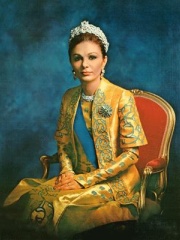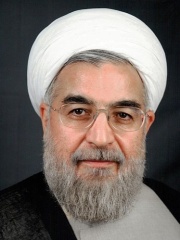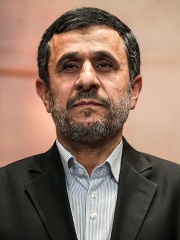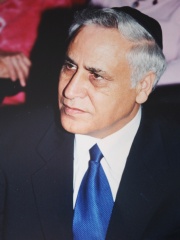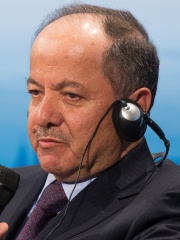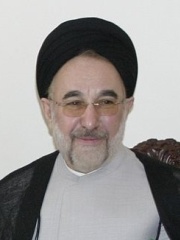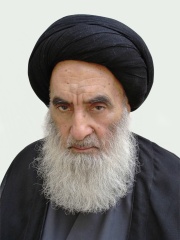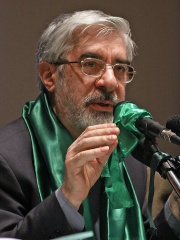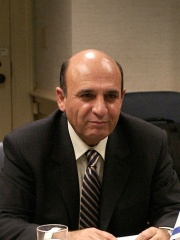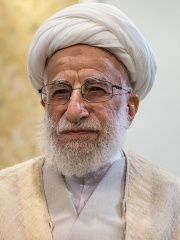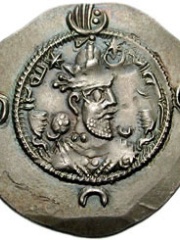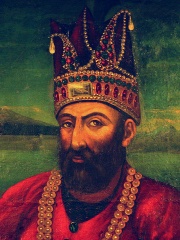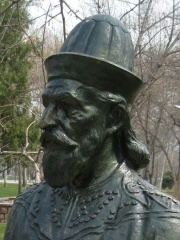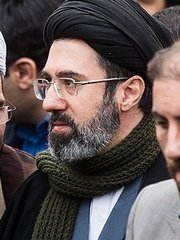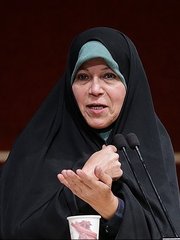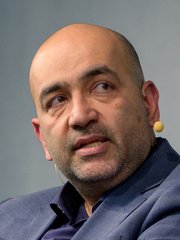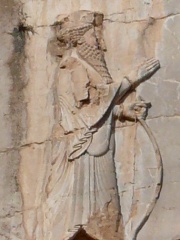
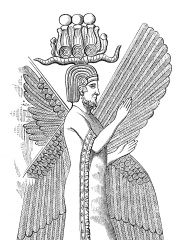
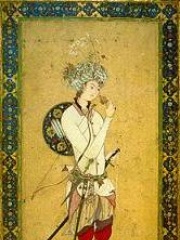
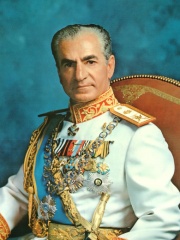
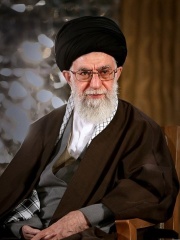
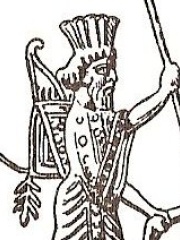
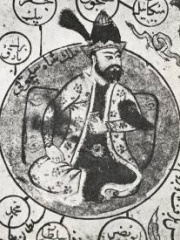
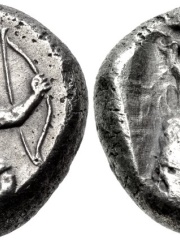
The Most Famous
POLITICIANS from Iran
This page contains a list of the greatest Iranian Politicians. The pantheon dataset contains 19,576 Politicians, 201 of which were born in Iran. This makes Iran the birth place of the 19th most number of Politicians behind Sweden, and Iraq.
Top 10
The following people are considered by Pantheon to be the top 10 most legendary Iranian Politicians of all time. This list of famous Iranian Politicians is sorted by HPI (Historical Popularity Index), a metric that aggregates information on a biography's online popularity. Visit the rankings page to view the entire list of Iranian Politicians.

1. Xerxes I (519 BC - 475 BC)
With an HPI of 87.97, Xerxes I is the most famous Iranian Politician. His biography has been translated into 84 different languages on wikipedia.
Xerxes I ( ZURK-seez; commonly known as Xerxes the Great; c. 518 BC – 465 BC) was a Persian ruler who served as the fourth King of Kings of the Achaemenid Empire, reigning from 486 BC until his assassination in 465 BC. He was the son of Darius the Great and Atossa, a daughter of Cyrus the Great. In Western history, Xerxes is best known for his invasion of Greece in 480 BC, which ended in Persian defeat. Xerxes was made successor by Darius over his elder brother Artobazan and inherited a large, multi-ethnic empire upon his father's death. He consolidated power by crushing revolts in Egypt and Babylon, and renewed his father's campaign to subjugate Greece and punish Athens and its allies for their interference in the Ionian Revolt. In 480 BC, Xerxes led a large army and crossed the Hellespont into Europe. He achieved victories at Thermopylae and Artemisium before capturing and razing Athens. His forces gained control of mainland Greece north of the Isthmus of Corinth until their defeat at the Battle of Salamis. Fearing that the Greeks might trap him in Europe, Xerxes retreated with the greater part of his army back to Asia, leaving behind Mardonius to continue his campaign. Mardonius was defeated at Plataea the following year, ending the Persian invasion. After returning to Persia, Xerxes dedicated himself to big construction projects, many of which had been left unfinished by his father. He oversaw the completion of the Gate of All Nations, the Apadana and the Tachara at Persepolis, and continued the construction of the Palace of Darius at Susa. He also maintained the Royal Road built by his father. In 465 BC, Xerxes and his heir Darius were assassinated by Artabanus, the commander of the royal bodyguard. He was succeeded by his third son, who took the throne as Artaxerxes I.

2. Cyrus the Great (600 BC - 530 BC)
With an HPI of 86.91, Cyrus the Great is the 2nd most famous Iranian Politician. His biography has been translated into 131 different languages.
Cyrus II of Persia (c. 600 – 530 BC), commonly known as Cyrus the Great, was the founder of the Achaemenid Empire. Hailing from Persis, he brought the Achaemenid dynasty to power by defeating the Median Empire and embracing all of the previous civilized states of the ancient Near East, expanding vastly across most of West Asia and much of Central Asia to create what would soon become the largest empire in history at the time. The Achaemenid Empire's greatest territorial extent was achieved under Darius the Great, whose rule stretched from Southeast Europe in the west to the Indus Valley in the east. After absorbing the Median Empire, Cyrus conquered Lydia and eventually the Neo-Babylonian Empire, granting him control of Anatolia and the Fertile Crescent, respectively. He also led a major expedition into Central Asia, where his army brought "into subjection every nation without exception" before he allegedly died in battle with the Massagetae, a nomadic Eastern Iranian people, along the Syr Darya in December 530 BC. However, according to Xenophon of Athens, Cyrus did not die fighting and had instead returned to the capital city of Pasargadae. Regardless of the date of his death, he was succeeded by his son Cambyses II, whose campaigns into North Africa led to the conquests of Egypt, Nubia, and Cyrenaica during his short rule. To the Greeks, he was known as Cyrus the Elder (Κῦρος ὁ Πρεσβύτερος Kŷros ho Presbýteros) and was particularly renowned among contemporary scholars because of his habitual policy of tolerance for peoples' customs and religions in the lands that he conquered. Similarly, he is exalted in Judaism for his role in freeing the Jewish people from the Babylonian captivity by issuing the Edict of Restoration following the Persian conquest of Babylon. This event is described in the Hebrew Bible as the return to Zion, whereby displaced Jews were repatriated to what had been the Kingdom of Judah, thus enabling the resurgence of a Jewish state in the Land of Israel. Cyrus also facilitated Jewish aspirations for a new Temple in Jerusalem in the Achaemenid Empire's Province of Judah, where the original Solomon's Temple had once stood before being destroyed during the Babylonian siege of Jerusalem. His efforts resulted in the completion of the Second Temple, which marked the beginning of the Second Temple period and Second Temple Judaism. According to the Book of Isaiah, he was anointed by Yahweh and explicitly designated "messiah" for this task; Cyrus is the only non-Jewish figure to be revered in this capacity. In addition to his influence on traditions in both the East and the West, Cyrus is recognized for his achievements in politics and military strategy. He was influential in developing the system of a central administration at his capital city to govern the Achaemenid Empire's satraps, who worked for the profit of both rulers and subjects. His realm's prestige in the ancient world would gradually reach as far west as Athens, where upper-class Greeks adopted aspects of the culture of the ruling Persian class as their own. Likewise, Cyrus's reign played a crucial role in defining the history of Iran for well over a millennium, as future Persian empires often viewed the Achaemenid era with deference and as the ideal example to emulate. His dynasty was also instrumental in allowing Zoroastrianism to develop and spread as far east as China. To this end, he remains a cult figure in modern Iran, with his Pasargadae tomb serving as a spot of reverence for millions of the country's citizens.

3. Harun al-Rashid (766 - 809)
With an HPI of 82.20, Harun al-Rashid is the 3rd most famous Iranian Politician. His biography has been translated into 83 different languages.
Abū Jaʿfar Hārūn ibn Muḥammad ar-Rashīd, or simply Hārūn ibn al-Mahdī (c. 763 or 766 – 24 March 809), famously known as Hārūn al-Rashīd, was the fifth Abbasid caliph of the Abbasid Caliphate, reigning from September 786 until his death in March 809. His reign is traditionally regarded to be the beginning of the Islamic Golden Age. His epithet al-Rashid translates to "the Just", "the Upright", or "the Rightly-Guided". Harun established the legendary library Bayt al-Hikma ("House of Wisdom") in Baghdad in present-day Iraq, and during his rule Baghdad began to flourish as a world center of knowledge, culture and trade. During his rule, the family of Barmakids, which played a deciding role in establishing the Abbasid Caliphate, declined gradually. In 796, he moved his court and government to Raqqa in present-day Syria. Domestically, Harun pursued policies similar to those of his father Al-Mahdi. He released many of the Umayyads and 'Alids his brother Al-Hadi had imprisoned and declared amnesty for all political groups of the Quraysh. Large scale hostilities broke out with Byzantium, and under his rule, the Abbasid Empire reached its peak. A Frankish mission came to offer Harun friendship in 799. Harun sent various presents with the emissaries on their return to Charlemagne's court, including a clock that Charlemagne and his retinue deemed to be a conjuration because of the sounds it emanated and the tricks it displayed every time an hour ticked. Portions of the fictional One Thousand and One Nights are set in Harun's court and some of its stories involve Harun himself. Harun's life and court have been the subject of many other tales, both factual and fictitious.

4. Mohammad Reza Pahlavi (1919 - 1980)
With an HPI of 82.03, Mohammad Reza Pahlavi is the 4th most famous Iranian Politician. His biography has been translated into 98 different languages.
Mohammad Reza Pahlavi (Persian: محمدرضا پهلوی [mohæmˈmæd reˈzɒː pæhlæˈviː]) (26 October 1919 – 27 July 1980) was the Shah of Iran from 1941 to 1979. He succeeded his father Reza Shah and ruled the Imperial State of Iran until he was overthrown by the 1979 Islamic Revolution led by Ruhollah Khomeini, which abolished the Iranian monarchy to establish the Islamic Republic of Iran. In 1967, he took the title Shahanshah (lit. 'King of Kings'), and also held several others, including Aryamehr (lit. 'Light of the Aryans') and Bozorg Arteshtaran (lit. 'Grand Army Commander'). He was the second and last ruling monarch of the Pahlavi dynasty. During World War II, the Anglo-Soviet invasion of Iran forced the abdication of Reza Shah and succession of Mohammad Reza Shah. During his reign, the British-owned oil industry was nationalized by the prime minister Mohammad Mosaddegh, who had support from Iran's national parliament to do so; however, Mosaddegh was overthrown in the 1953 Iranian coup d'état, which was carried out by the Iranian military under the aegis of the United Kingdom and the United States. Subsequently, the Iranian government centralized power under the Shah and brought foreign oil companies back into the country's industry through the Consortium Agreement of 1954. In 1963, Mohammad Reza Shah introduced the White Revolution, a series of reforms aimed at transforming Iran into a global power and modernizing the nation by nationalizing key industries and redistributing land. The regime also implemented Iranian nationalist policies establishing numerous popular symbols of Iran relating to Cyrus the Great. The Shah initiated major investments in infrastructure, subsidies and land grants for peasant populations, profit sharing for industrial workers, construction of nuclear facilities, nationalization of Iran's natural resources, and literacy programs which were considered some of the most effective in the world. The Shah also instituted economic policy tariffs and preferential loans to Iranian businesses which sought to create an independent Iranian economy. Manufacturing of cars, appliances, and other goods in Iran increased substantially, creating a new industrialist class insulated from threats of foreign competition. By the 1970s, the Shah was seen as a master statesman and used his growing power to pass the 1973 Sale and Purchase Agreement. The reforms culminated in decades of sustained economic growth that would make Iran one of the fastest-growing economies among both the developed world and the developing world. During his 37-year-long rule, Iran spent billions of dollars' worth on industry, education, health, and military spending. Between 1950 and 1979, real GDP per capita nearly tripled from about $2700 to about $7700 (2011 international dollars). By 1977, the Shah's focus on defense spending to end foreign powers' intervention in the country had culminated in the Iranian military standing as the world's fifth-strongest armed force. As political unrest grew throughout Iran in the late 1970s, the Shah's position was made untenable by the Cinema Rex fire and the Jaleh Square massacre. The 1979 Guadeloupe Conference saw his Western allies state that there was no feasible way to save the Iranian monarchy from being overthrown. The Shah ultimately left Iran for exile in January 1979. Although he had told some Western contemporaries that he would rather leave the country than fire on his own people, estimates for the total number of deaths during the Islamic Revolution range from 540 to 2,000 (figures of independent studies) to 60,000 (figures of the Islamic government). After formally abolishing the Iranian monarchy, Shia Islamist cleric Ayatollah Ruhollah Khomeini assumed leadership as the Supreme Leader of Iran. Mohammad Reza Shah died in exile in Egypt, where he had been granted political asylum by Egyptian president Anwar Sadat, and his son Reza Pahlavi declared himself the new Shah of Iran in exile.
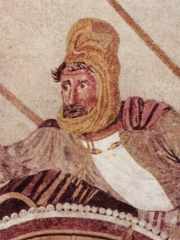
5. Darius III (380 BC - 330 BC)
With an HPI of 81.71, Darius III is the 5th most famous Iranian Politician. His biography has been translated into 76 different languages.
Darius III (Old Persian: 𐎭𐎠𐎼𐎹𐎺𐎢𐏁 Dārayavaʰuš; Ancient Greek: Δαρεῖος Dareios; c. 380 – 330 BC) was the thirteenth and last Achaemenid King of Kings of Persia, reigning from 336 BC to his death in 330 BC. Contrary to his predecessor Artaxerxes IV Arses, Darius was a distant member of the Achaemenid dynasty. During his early career, he was reportedly an obscure figure among his peers and first rose to prominence during the Cadusian expedition of Artaxerxes III in the 350s BC. As a reward for his bravery, he was given the Satrapy of Armenia. Around 340 BC, he was placed in charge of the royal "postal service," a high-ranking position. In 338 BC, Artaxerxes III met an abrupt end after being poisoned by the court eunuch and chiliarch (hazahrapatish) Bagoas, who installed Artaxerxes' youngest son Arses on the throne. He only reigned for a few years, until Bagoas had him poisoned as well. Darius was subsequently installed on the throne and soon forced Bagoas to drink his poison after discovering that the eunuch had planned to poison him as well. In 334 BC, Alexander the Great began his invasion of the Persian Empire and subsequently defeated the Persians in several battles before looting and destroying their capital, Persepolis, by fire in 330 BC. With the Persian Empire now effectively under Alexander's control, Alexander then decided to pursue Darius. Before Alexander reached him, however, Darius was killed by his relative Bessus, who was also the satrap of Bactria.

6. Ali Khamenei (b. 1939)
With an HPI of 81.36, Ali Khamenei is the 6th most famous Iranian Politician. His biography has been translated into 101 different languages.
Seyyed Ali Hosseini Khamenei (born 19 April 1939) is an Iranian cleric and politician who has served as the second supreme leader of Iran since 1989. His tenure as supreme leader, spanning 36 years, makes him the longest-serving head of state in the Middle East and the longest-serving Iranian leader since Shah Mohammad Reza Pahlavi. Born into the Khamenei family, he studied at a hawza in his hometown Mashhad, later settling in Qom in 1958 where he attended the classes of Ruhollah Khomeini. Khamenei became involved in opposition to Mohammad Reza Pahlavi, the shah of Iran, and was arrested six times before being exiled for three years by the Shah's regime. Khamenei was a mainstream figure in the 1978–1979 Iranian Revolution, and upon its success, held many posts in the newly established Islamic Republic of Iran. In the aftermath of the revolution, he was the target of an attempted assassination that paralysed his right arm. There have been continued assassination threats against Ali Khamenei by Israel. Khamenei served as the third president of Iran from 1981 to 1989 during the Iran–Iraq War, when he also developed close ties to the Islamic Revolutionary Guard Corps (IRGC). After the death of Khomeini in 1989, Khamenei was elected supreme leader by the Assembly of Experts. As supreme leader, Khamenei supported Iran's nuclear program for civilian use while issuing a fatwa forbidding the production of weapons of mass destruction. Khamenei favoured economic privatization of state-owned industries and, with oil and gas reserves, transformed Iran into an "energy superpower". His foreign policy has centered on Shia Islamism and exporting the Iranian Revolution. Under Khamenei, Iran supported the "Axis of Resistance" coalition in the Syrian civil war, War in Iraq, Yemeni civil war and the Gaza war, as well as Russia during Russo-Ukrainian war. A staunch critic of Israel and of Zionism, Khamenei has supported the Palestinians in the Israeli–Palestinian conflict; his rhetoric has included calls for Israel's destruction and antisemitic tropes. Under Khamenei, Iran has been involved in proxy wars with Israel, Saudi Arabia and Turkey; in 2025, tensions with Israel escalated to a 12-day armed conflict. Khamenei has also faced many protests during his reign, including the 1999 Iranian student protests, the 2009 Iranian presidential election protests, the 2011–2012 Iranian protests, the 2017–2018 Iranian protests, the 2018–2019 Iranian general strikes and protests, the 2019–2020 Iranian protests, and the Mahsa Amini protests. Journalists, bloggers and other individuals have been put on trial in Iran for the charges of insulting Supreme Leader Khamenei, often in conjunction with blasphemy charges. Their sentences have included lashing and jail time; some of them have died in custody. He is also known by the title Ayatollah and is considered one of the leading Shia Muslim marja' in the world. Khamenei's critics view him as a repressive despot responsible for repression, mass murders and other acts of injustice.

7. Cambyses II (550 BC - 522 BC)
With an HPI of 78.72, Cambyses II is the 7th most famous Iranian Politician. His biography has been translated into 67 different languages.
Cambyses II was the second King of Kings of the Achaemenid Empire, reigning 530 to 522 BCE. He was the son of and successor to Cyrus the Great (r. 550 – 530 BC); his mother was Cassandane. His relatively brief reign was marked by his conquests in North Africa, notably Egypt, which he took by defeating pharaoh Psamtik III (r. 526–525 BC) at the battle of Pelusium in 525 BC. After his victory in Egypt, he expanded the empire's holdings in Africa by taking Cyrenaica, the coastal region of eastern Libya. In the spring of 522 BC, Cambyses had to leave Egypt hastily to put down a revolt in Persia. En route in Syria (Eber-Nari), Cambyses somehow received a thigh wound; it soon became gangreneous. Cambyses died three weeks later in Agbatana, likely the modern city of Hama. He died childless, and was thus succeeded by his younger brother Bardiya. Bardiya ruled for a short time, and was then overthrown by Darius the Great (r. 522–486 BC), who went on to increase the power of the Achaemenids even further. Before his accession, Cambyses was governor of northern Babylonia under his father Cyrus from April to December 538 BCE. He held positions in Babylon and Sippar. In 530 BCE his father made him co-ruler. Cyrus then set off on an expedition against the Massagetae of Central Asia, where he met his end. Cambyses thus became the sole ruler of the vast Achaemenid Empire. According to chroniclers, he faced no opposition.

8. Malik-Shah I (1055 - 1092)
With an HPI of 78.06, Malik-Shah I is the 8th most famous Iranian Politician. His biography has been translated into 51 different languages.
Malik-Shah I (Persian: ملک شاه یکم) was the third sultan of the Seljuk Empire from 1072 to 1092, under whom the sultanate reached the zenith of its power and influence. During his youth, he spent his time participating in the campaigns of his father Alp Arslan, along with the latter's vizier Nizam al-Mulk. During one such campaign in 1072, Alp Arslan was fatally wounded and died only a few days later. After that, Malik-Shah was crowned as the new sultan of the empire, but the succession was contested by his uncle Qavurt. Although Malik-Shah was the nominal head of the Seljuk state, Nizam al-Mulk held near absolute power during his reign. Malik-Shah spent the rest of his reign waging war against the Karakhanids to the east and establishing order in the Caucasus. The cause of Malik-Shah's death remains under dispute to this day; according to some scholars, he was poisoned by Abbasid caliph al-Muqtadi, while others say that he was poisoned by the supporters of Nizam al-Mulk.

9. Xerxes II of Persia (500 BC - 424 BC)
With an HPI of 77.43, Xerxes II of Persia is the 9th most famous Iranian Politician. His biography has been translated into 46 different languages.
Xerxes II ( ZURK-seez; Old Persian: 𐎧𐏁𐎹𐎠𐎼𐏁𐎠, romanized: Xšayār̥šā; Ancient Greek: Ξέρξης, romanized: Xérxēs; died 424 BC) was a Persian king who was very briefly a ruler of the Achaemenid Empire, as the son and successor of Artaxerxes I. After a reign of forty-five days—where he only had control over the Persian heartlands—he was assassinated in 424 BC by his half-brother Sogdianus, who in turn was murdered by Darius II six months later. He is an obscure historical figure known primarily from the writings of Ctesias. He was the only legitimate son of Artaxerxes I and Damaspia, and is known to have served as crown prince.
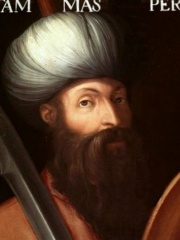
10. Tahmasp I (1514 - 1576)
With an HPI of 77.27, Tahmasp I is the 10th most famous Iranian Politician. His biography has been translated into 55 different languages.
Tahmasp I (Persian: طهماسب یکم, romanized: Ṭahmāsb or تهماسب یکم Tahmâsb; 22 February 1514 – 14 May 1576) was the second shah of Safavid Iran from 1524 until his death in 1576. He was the eldest son of Shah Ismail I and his principal consort, the Mawsillu princess Tajlu Khanum. Tahmasp ascended the throne after the death of his father on 23 May 1524. The first years of Tahmasp's reign were marked by civil wars between the Qizilbash leaders until 1532, when he asserted his authority and began an absolute monarchy. He soon faced a long-lasting war with the Ottoman Empire, which was divided into three phases. The Ottoman sultan, Suleiman the Magnificent, tried to install his own candidates on the Safavid throne. The war ended with the Peace of Amasya in 1555, with the Ottomans gaining sovereignty over Iraq, much of Kurdistan, and western Georgia. Tahmasp also had conflicts with the Uzbeks of Bukhara over Khorasan, with them repeatedly raiding Herat. In 1528, at the age of fourteen, he defeated the Uzbeks in the Battle of Jam by using artillery. Tahmasp was a patron of the arts and was an accomplished painter himself. He built a royal house of arts for painters, calligraphers and poets. Later in his reign, he came to despise poets, shunning many and exiling them to the Mughal court of India. Tahmasp is known for his religious piety and fervent zealotry for the Shia branch of Islam. He bestowed many privileges on the clergy and allowed them to participate in legal and administrative matters. In 1544 he demanded that the fugitive Mughal emperor Humayun convert to Shi'ism in return for military assistance to reclaim his throne in India. Nevertheless, Tahmasp still negotiated alliances with the Christian powers of the Republic of Venice and the Habsburg monarchy who were also rivals of the Ottoman Empire. Tahmasp's succession was disputed even before his death; after his death a civil war erupted, causing the deaths of most of the royal family. His reign, spanning nearly fifty-two years, was the longest of any Safavid ruler. While contemporary Western accounts were critical of him, modern historians recognize Tahmasp as a courageous and capable commander who preserved and expanded his father's empire. His reign marked a pivotal shift in Safavid ideological policy: he ended the Turkoman Qizilbash tribes' veneration of his father as the Messiah and instead established himself as a pious and orthodox Shia king. Tahmasp also initiated a long-term process, later continued by his successors, to diminish Qizilbash influence in Safavid politics. This was achieved by introducing a "third force" composed of Islamized Georgians and Armenians.
People
Pantheon has 201 people classified as Iranian politicians born between 1300 BC and 2002. Of these 201, 38 (18.91%) of them are still alive today. The most famous living Iranian politicians include Ali Khamenei, Farah Pahlavi, and Hassan Rouhani. The most famous deceased Iranian politicians include Xerxes I, Cyrus the Great, and Harun al-Rashid. As of April 2024, 8 new Iranian politicians have been added to Pantheon including Mojtaba Khamenei, Alireza Akbari, and Faezeh Hashemi Rafsanjani.
Living Iranian Politicians
Go to all RankingsAli Khamenei
1939 - Present
HPI: 81.36
Farah Pahlavi
1938 - Present
HPI: 75.83
Hassan Rouhani
1948 - Present
HPI: 75.45
Mahmoud Ahmadinejad
1956 - Present
HPI: 74.60
Moshe Katsav
1945 - Present
HPI: 73.42
Masoud Barzani
1946 - Present
HPI: 73.21
Mohammad Khatami
1943 - Present
HPI: 71.09
Ali al-Sistani
1930 - Present
HPI: 70.22
Mir-Hossein Mousavi
1942 - Present
HPI: 65.62
Shaul Mofaz
1948 - Present
HPI: 62.87
Farahnaz Pahlavi
1963 - Present
HPI: 61.20
Ahmad Jannati
1927 - Present
HPI: 60.67
Deceased Iranian Politicians
Go to all RankingsXerxes I
519 BC - 475 BC
HPI: 87.97
Cyrus the Great
600 BC - 530 BC
HPI: 86.91
Harun al-Rashid
766 - 809
HPI: 82.20
Mohammad Reza Pahlavi
1919 - 1980
HPI: 82.03
Darius III
380 BC - 330 BC
HPI: 81.71
Cambyses II
550 BC - 522 BC
HPI: 78.72
Malik-Shah I
1055 - 1092
HPI: 78.06
Xerxes II of Persia
500 BC - 424 BC
HPI: 77.43
Tahmasp I
1514 - 1576
HPI: 77.27
Khosrow I
501 - 579
HPI: 77.21
Nader Shah
1688 - 1747
HPI: 76.87
Nizam al-Mulk
1018 - 1092
HPI: 76.49
Newly Added Iranian Politicians (2025)
Go to all RankingsMojtaba Khamenei
1969 - Present
HPI: 59.07
Alireza Akbari
1961 - 2023
HPI: 51.72
Faezeh Hashemi Rafsanjani
1963 - Present
HPI: 48.79
Omid Nouripour
1975 - Present
HPI: 44.37
Arash Miresmaeili
1981 - Present
HPI: 37.74
Amir Sarkhosh
1991 - Present
HPI: 37.67
Rahman Amouzad
2002 - Present
HPI: 35.35
Saba Kord Afshari
HPI: 29.05
Overlapping Lives
Which Politicians were alive at the same time? This visualization shows the lifespans of the 25 most globally memorable Politicians since 1700.

